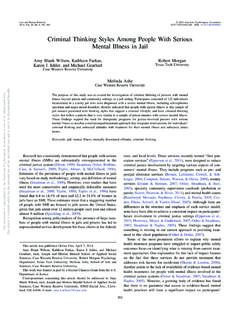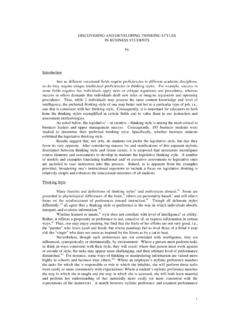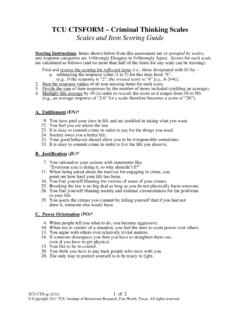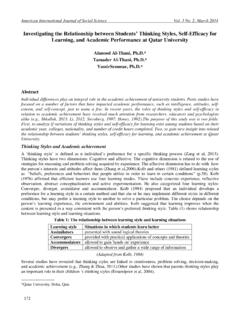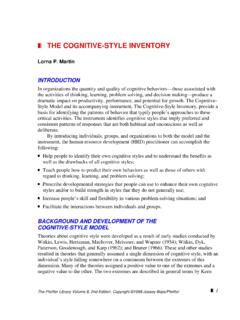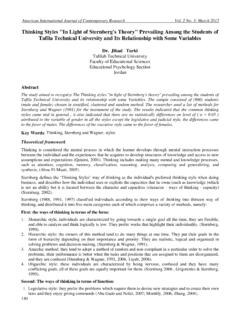Transcription of Thinking style and emotional intelligence: An empirical ...
1 Journal of Behavioral Studies in Business Thinking style , page 1 Thinking style and emotional intelligence : an empirical investigation T. Winters Moore East Tennessee State University J. Blake Snider East Tennessee State University Mark Luchini East Tennessee State University ABSTRACT The purpose of this paper was to empirically examine the conceptual links between Thinking styles and emotional intelligence . The paper reviews pertinent literature about Thinking styles and emotional intelligence . Findings from the literature review suggest that Thinking styles can be conceptualized as right-brained, left-brained, or whole-brained and can be measured with the subscales of the MBTI.
2 Findings also revealed that although emotional intelligence has been measured a number of ways in the extant literature; the key processes of management and awareness are most closely related to Thinking styles . Based on the review of literature, a number of specific hypotheses about the pattern of relationships between Thinking styles and emotional intelligence concepts were tested. Analytical findings revealed that both left and right-brained Thinking styles are related to emotional intelligence variables in conceptually expected directions. Keywords: emotional intelligence , Thinking style , Leadership Copyright statement: Authors retain the copyright to the manuscripts published in AABRI journals.
3 Please see the AABRI Copyright Policy at Journal of Behavioral Studies in Business Thinking style , page 2 INTRODUCTION There is a narrative circulating in many management circles that starts with the idea that highly technical people typically arrive at the top of their given area of expertise through intense focus on logical analysis, problem resolution, technical terminology understanding, and proficiency in specific areas of their chosen field. Another key feature of this narrative is that academia has also followed course by focusing its educational programs in these areas. This learning process is typically reinforced in their careers by continued learning of the exact same skills via company financed conferences, seminars and various forms of advanced discipline education.
4 As the person becomes more of an expert, they are generally more respected and regarded by their management and peers bringing about a certain, possibly incorrect, aura of referent and expert leadership and management qualities. Once they reach the top of the non-management hierarchy, the normal course of action is many times to automatically assume them for promotion into a frontline management position. Typically, both the employee and their managers expect this as a natural progression up the corporate ladder. This work hard and keep moving up idealism is in itself an ingrained part of general business culture and expectations.
5 To the extent that this narrative exists in the real world, it follows that while this model may work in many traditional non-technical occupations, the highly technical person often times falls short showing an incredible lack of emotional intelligence , which is a major factor in management and leadership success (Bradberry & Greaves, 2009). They struggle with their inability to relate to people, their lack of understanding personal inter-relationship intricacies, and failure to be an empathetic encourager, mentor and leader to their staff and teams. More simply put, many times in the case of the technical professional desiring to move into management, as Goldsmith (2007) says, What Got You Here, Won t Get You There , (Goldsmith, 2007).
6 While interpersonal skills are necessary to manage in any discipline, the highly technical person often times has the intrinsic, erroneous belief that his or her expert technical knowledge and ranking, alone, automatically makes them good managerial candidates. Goldsmith (2007) says: It s not that these people don t know who they are or where they re going or what they want to achieve. Nor is it that they don t have an adequate sense of self-worth. In fact, they tend to be very successful (and their self-esteem can often be excessive). What s wrong is that they have no idea how their behavior is coming across to the people who matter - their bosses, colleagues, subordinates, customers, and think they have all the answers but others see it as arrogance.
7 (Goldsmith, 2007, ). Prior to this transformation from technical superstar to management-leader, time must be spent to ensure this is the proper course of advancement for the individual involved because oftentimes the reason that individuals struggle so much in management and leadership roles may be a result of their Thinking style ( brain dominance). While no firm empirical evidence could be found for this narrative, it illustrates the importance of personal characteristics such as Thinking style and emotional intelligence for the successful leader. The goal of this manuscript, therefore, is to develop a theoretical and empirical link between individual Thinking style , discussed as brain dominance, and emotional intelligence .
8 Drawing from previous research, the constructs of sensing or intuition and Thinking or feeling from the Myers-Briggs type indicator are discussed as proxy measures for left, right, Journal of Behavioral Studies in Business Thinking style , page 3 and whole brain Thinking styles . A theoretical connection between Thinking style and the concepts of emotional intelligence awareness and emotional intelligence management from the emotional intelligence literature is then proposed. LITERATURE REVIEW AND HYPOTHESIS DEVELOPMENT Brain Hemisphere Dominance Left and right brain hemispheric distinctions have been long reviewed and debated among scientists and academic scholars.
9 Some of the earliest documented research in brain lateralization came from nineteenth century French physician and surgeon Pierre Paul Broca. Broca discovered through his medical practice, a link between brain hemispheres and speech and other cognitive skills. According to Venita (2002), The first cortical localization that became widely accepted linked fluent articulate speech to the frontal lobes. Cortical localization of speech was a much debated Broca s epoch presentation in 1861 , (Venita, 2002, p. 1). These findings, in turn, created an area of research that evolved into defining specific traits, characteristics of thought processes, and emotions as localized to the two distinct hemispheres of the brain.
10 A leading researcher in this area was William E. Ned Herrmann. Hermann s research developed and popularized the left and right brain model of actions, thought processes and personality. The brain hemisphere dominance theorem was further refined by Herrmann, and others, into a model of whole brain Thinking which identified four distinct areas of brain thought: (1) Rational self, (2) Experimental Self, (3) Safekeeping self, and (4) Feeling self. (Herrmann, 1996). This new model was embraced and enhanced again by many researchers including Clayton and Kimbrell (2007) who state: The model is quadripartite in that two types of dominance are designed for each [brain] hemisphere: (1) Cerebral left: the analytical, logical, problem-solving person; (2) Lower left: the reliable, organized, controlling, conservative person; (3) Cerebral right: the creative, conceptual, synthesizing person; (4) Lower right: the interpersonal, emotional , sensitive, musical person.










